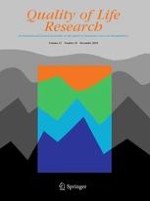01-12-2014
Health status profiles in community-dwelling elderly using self-reported health indicators: a latent class analysis
Gepubliceerd in: Quality of Life Research | Uitgave 10/2014
Log in om toegang te krijgenAbstract
Purpose
Latent class analysis (LCA), a statistical method for identifying latent classes within a population using multiple indicators, has been used to study the heterogeneity of health among the elderly. We aim to identify health status profiles of older adults using LCA and examine the socio-demographic characteristics associated with each profile.
Methods
A community health survey of residents ≥60 years was conducted in Marine Parade, Singapore. We performed LCA on seven health indicators (number of chronic conditions, activities of daily living (ADL) dependency, pain, depression, cognition, social isolation, and frequency of socialising) to identify distinct classes of health status profiles. Multivariable logistic regression was conducted to examine the socio-demographic characteristics associated with each profile.
Results
Of the 2,444 elderly interviewed, we identified two health status profiles: “Health at risk” (n = 465, 19.0 %), and “Relatively healthy” (n = 1,979, 81.0 %). The “Health at risk” profile was characterised by high probabilities of 3+ chronic conditions (λ = 0.63), at least one basic/instrumental ADL dependency (λ = 0.56), moderate/extreme pain (λ = 0.55), cognitive impairment (λ = 0.29), depressive symptoms (λ = 0.29), social isolation (λ = 0.27), and infrequent socialisation (λ = 0.61). Individuals who were older (65–74, 75–84, and 85+ years), females, of non-Chinese ethnicity (Indian, Malay, and Others), had primary and lower education, and were unemployed/not employed were more likely to be “Health at risk”.
Conclusion
Using LCA, we identified two distinct health status profiles which accounted for the heterogeneity of the elderly population. Selected socio-demographic characteristics were associated with different profiles and provide implications for the structuring of future public health interventions targeting the older population.
